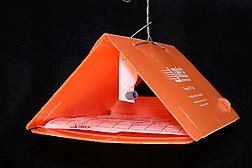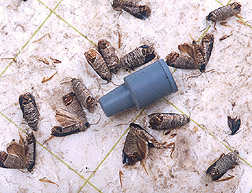New, Improved Codling Moth Lures Available
New lures that entice codling moths with the scent of food and a possible mate are available for use in monitoring this orchard pest and controlling it with carefully timed applications of insecticide. The research related to the development and use of the lures involved scientists Alan Knight and Peter Landolt at the Agricultural Research Service’s Yakima Agricultural Research Laboratory in Wapato, Washington, and Douglas Light at the ARS Western Regional Research Center in Albany, California.
As larvae, codling moths are major pests of apples, pears, and walnuts. Historically, growers have sprayed their orchards with insecticide to prevent the pinkish-white, 3/4-inch-long larvae from holing up inside the fruit to feed, damaging it and ruining its marketability—both domestically and abroad.
Lures baited with synthetic versions of the adult female moth’s chemical sex attractant, or sex pheromone, have helped growers refine their timing of insecticide and reduce the amount applied. As part of research to improve the technology further, a team of ARS and collaborating scientists has identified and synthesized new compounds to add with the sex pheromone. Among these are pear ester and acetic acid.
Pear ester is the characteristic aroma of ripe pears and acetic acid is what makes vinegar tangy.
Pear ester alone is a potent attractant for both sexes of codling moth. Adding acetic acid significantly increases the number caught. But the most powerful lure resulted from combining pear ester, sex pheromone, and acetic acid, the researchers found. Indeed, studies indicate that the combined lure can capture 8 to 10 times more female moths than the pear ester-pheromone combination alone can.
Using lure-based monitoring tools, the researchers developed action thresholds (based on both female and total moth catches) for growers that have enabled insecticide reductions of 30 to 70 percent.
Orchard trials conducted with Washington State University entomologist Jay Brunner over 2 years found that combining the pear ester-pheromone lures with acetic acid can also be used effectively to monitor apple leafrollers—considered important secondary pests. This will allow growers to more easily establish management thresholds for leafrollers concurrently with codling moths.—By Jan Suszkiw, Agricultural Research Service Information Staff.
This research is part of Crop Protection and Quarantine, an ARS national program (#304) described at www.nps.ars.usda.gov.
To reach scientists featured in this article, contact David Nicholson, Research Operations and Management, Office of Technology Transfer, 800 Buchanan St., Albany, CA 94710; (510) 559-5641.
"New, Improved Codling Moth Lures Available" was published in the July 2013 issue of Agricultural Research magazine.








